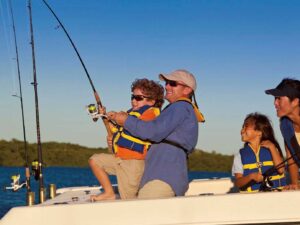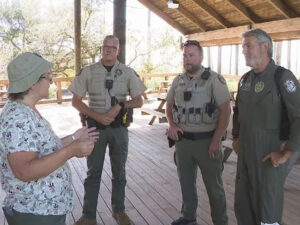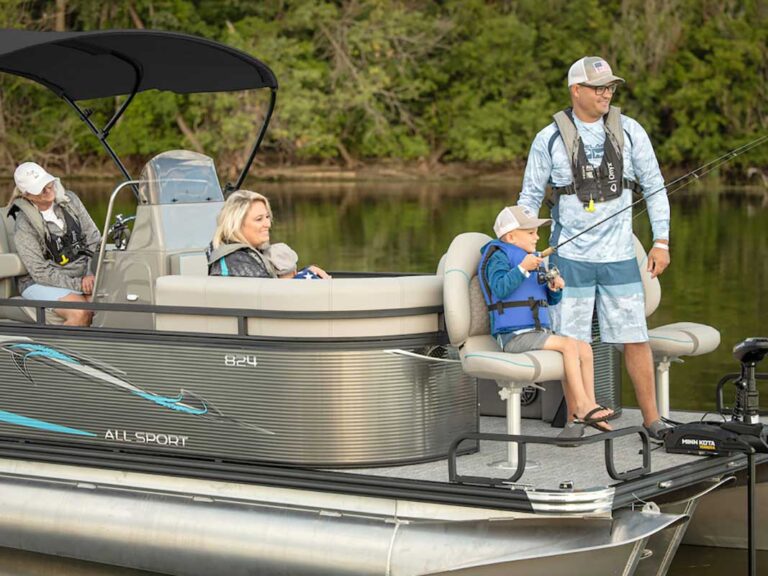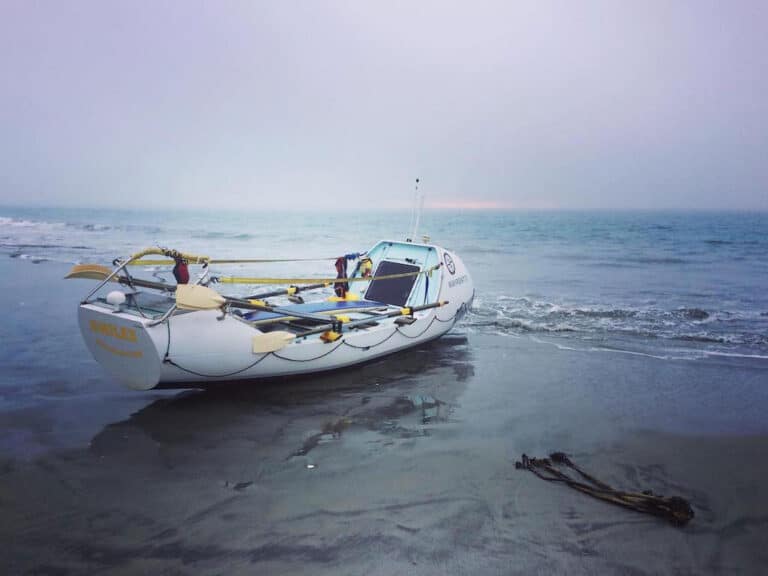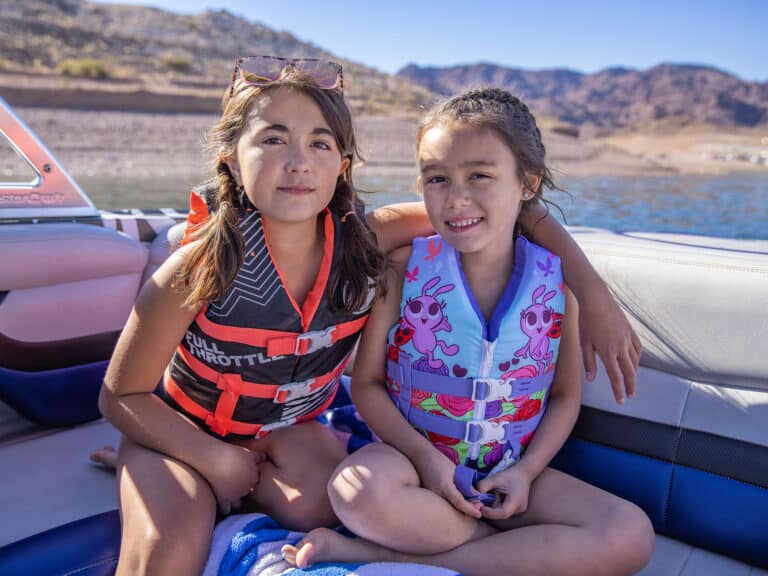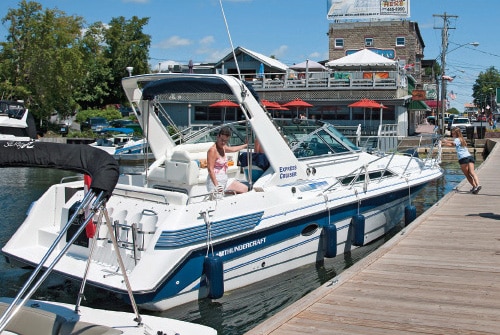
I’ve been unceremoniously cut off before, but this guy did it with aplomb. It was a holiday weekend with one fuel dock open and a queue of boats circling. Just as I was shaping up to sidle alongside, a go-fast surges between my old convertible and the dock and hits hard reverse. In a flash, the guy is ashore and grabbing the fuel hose the attendant was holding for me. He pointedly doesn’t look my way, but his girlfriend, sprawled on the forward sun pad, gives me a “got-ya” smile. OK, it takes all kinds. I shrugged my shoulders and slid into the spot that opened astern of him.
The attendant runs over and grabs a line; I look down from the flybridge. The go-fast dude is really in a hurry. He has a bowline casually looped on a dock cleat. While pumping fuel, he has one foot on the dock and the other on the aft deck. The boat slowly begins to drift off. The gap between his legs widens; suddenly, it’s decision time. He opts for the dock and stumbles backward, leaving the fuel nozzle in the tank. As he heads toward the bow to yank the boat in, the nozzle jumps out and sprays fuel until the water resembles a rainbow parade. Suffice it to say, the story doesn’t end there, but we’ll talk about legalities, fines and penalties at a later date.
We all experience the need for short tie-ups. And granted, if you’re just swinging in to refuel or to pick up a six-pack, it’s a pain to go the whole route of fore and aft lines, springs, etc. On the other hand, it’s nice if the boat is still there when you turn your back for a few minutes.
My preferred stop-and-go method has always relied on the midship spring. On that note, I should say any vessel that doesn’t have a cleat located at or near its midpoint is not properly equipped.
That cleat can be a lifesaver in any number of situations — first, when coming in for that short stop. If the boat’s midship cleat — be it a runabout or yacht — is placed directly across from a cleat on the dock and it’s taken up tight, where can the boat go? That cleat-to-cleat bond will serve as a fulcrum of sorts, allowing the bow and/or the stern to drift out just so much.
Here’s the small print: If the tie-up is for a short time — while refueling or running into the dockside shack — and someone competent is left aboard, no other lines are necessary. The boat, however, should never be left unattended, and it should be well-fendered. Using a midship cleat, as such, works best on floating docks. If there are heavy swells, wakes rolling in or significant wind, it’s not a good idea and the boat should be secured traditionally. Obviously, if the vessel is going to be left unattended for any amount of time, it needs to be secured properly with bow and stern lines as well as fore and aft springs.
Another plug for the midship cleat involves its use in everyday docking situations. For instance, stand on any dock and watch how most boats approach and tie up. Often, the bowline is sent over first. That’s a no-brainer. When making an approach, the easiest thing to do is to point the bow in. And it makes sense; if the approach isn’t to the skipper’s liking, it’s easier to back or veer off from a bow-on position. But what happens if the bowline is set up on the boat, the line is also secured on the dock and the boat has a bit too much way on? That bowline, in effect, becomes a forward spring, Newton’s Law takes over and “crunch.”
Let’s take the same angle of attack, but the initial line sent ashore is bent to the midship cleat and then led forward rather than being bent directly to the bow cleat. The line is then handed to a person ashore, or a crew member can step on the dock with it. The skipper can then come ahead or go astern with confidence, as the line can be easily controlled from aboard.
When attempting a single-handed approach, depending on the vessel, it’s usually more convenient for the boat’s operator to reach a midship line rather than a bowline. Either way, if the midship line sets up inadvertently, the bow won’t catapult in and take a hit. Instead, under most conditions, the boat will approach the dock broadside rather than bow-in, especially if the skipper comes ahead while steering away from the dock.
Using that midship spring can allow a vessel to come into a dock space just slightly longer than its length — for instance, between two other boats on a fuel dock. Each time the boat is given a small burst of forward throttle, it not only comes ahead on the spring, it also gets closer — and still parallel — to the dock. Then, by coming astern, the skipper can limit forward motion while excess line is taken in. The process is repeated until you’re alongside. Like everything else, it takes practice to do this single-handedly or even with coordination between skipper, crew and dock personnel. Of course, fendering is essential.
As in any situation where someone takes lines on a dock, the line must always be controlled from aboard. The person ashore needs to be sent a looped line and told where to place it, all adjustments being made from the boat. Anything short of that means control of the boat is being handed over to the line handler on the dock. You can bet when something goes wrong, the dockside line handler won’t be at fault — it’ll be, and rightly so, the skipper’s fault.
The U.S. Coast Guard is asking all boat owners and operators to help reduce fatalities, injuries, property damage, and associated healthcare costs related to recreational boating accidents by taking personal responsibility for their own safety and the safety of their passengers. Essential steps include: wearing a life jacket at all times and requiring passengers to do the same; never boating under the influence (BUI); successfully completing a boating safety course; and getting a Vessel Safety Check (VSC) annually from local U.S. Coast Guard Auxiliary, United States Power Squadrons(r), or your state boating agency’s Vessel Examiners. The U.S. Coast Guard reminds all boaters to “Boat Responsibly!” For more tips on boating safety, visit www.uscgboating.org.

